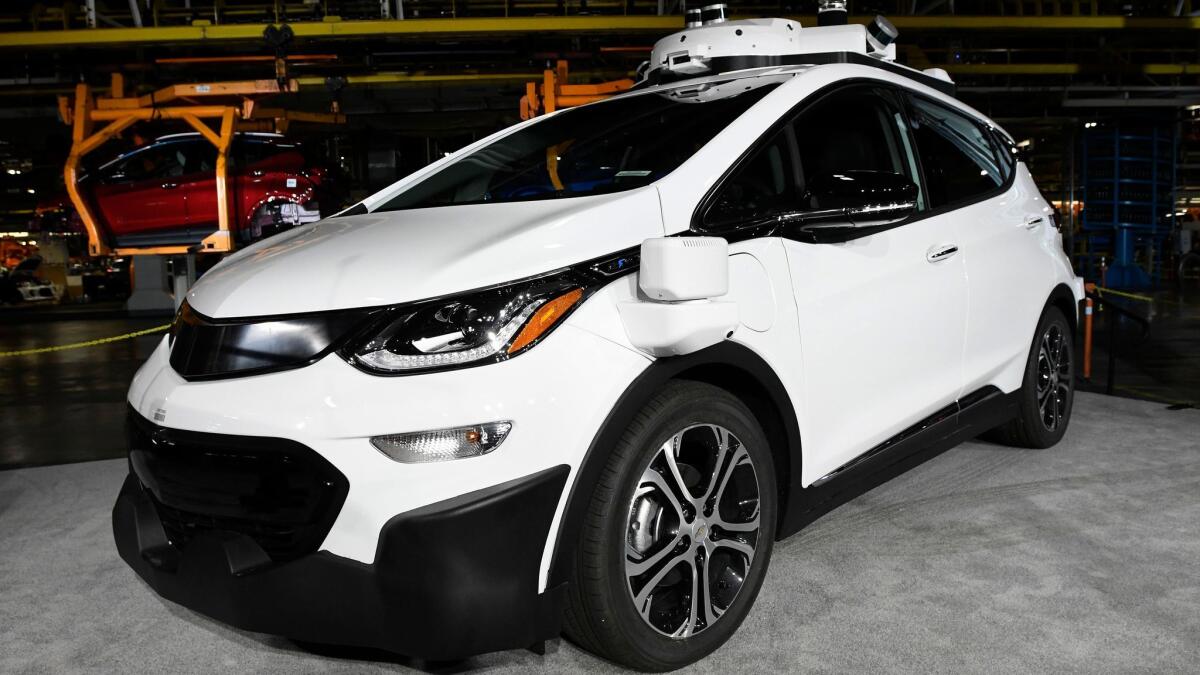GM drops the steering wheel and pedals for its self-driving Bolt

- Share via
Next year, General Motors Co. will no longer need an engineer in the front seat babysitting the robot brain that controls its self-driving Chevrolet Bolt. The steering wheel and pedals will be gone, giving total control to the machine.
When GM starts testing its autonomous electric sedan in San Francisco ride-sharing fleets, it’ll likely be the first production-ready car on the roads without the tools to let a human assume control. The announcement Friday is the first sign from a major carmaker that engineers have enough confidence in self-driving cars to let them truly go it alone.
“What’s really special about this is if you look back 20 years from now, it’s the first car without a steering wheel and pedals,” said Kyle Vogt, chief executive officer of Cruise Automation, the San Francisco-based unit developing the software for GM’s self-driving cars.
GM will run the cars in a test batch for a ride-sharing program starting in 2019, and they won’t be without a safety net. The vehicles will travel on a fixed route controlled by their mapping system, and the Detroit-based automaker is applying for federal permission to run the test cars without a driver.
Vogt said the self-driving Bolt has redundant systems built in to back up the driving systems. If there’s a problem, the car will slow down, pull over to the roadside and stop.
GM’s experiment will be a significant step forward for self-driving cars. The automaker and companies including Alphabet Inc.’s Waymo unit and startup Zoox Inc. have demonstrated cars that can drive with so-called Level 4 autonomy. As defined by the Society of Automotive Engineers, cars at that level can drive without human intervention but only in certain geographic areas.
GM, Zoox, Waymo and others have all tested Level 4 cars, but usually with a driver still at the wheel to take over in case the system doesn’t work properly. Removing the driver will really test the technology, said Gill Pratt, CEO of Toyota Motor Corp.’s Toyota Research Institute.
“If you’re testing Level 4 technology with a driver, you’re not really testing it at level 4,” he said in an interview at the CES technology show in Las Vegas this week.
Waymo and its precursor, Google’s self-driving car project, have tested autonomous vehicles in urban areas for years. Its Firefly prototype had no steering wheel or pedals, and in 2015 it took a blind man for what the company called “the world’s first truly self-driving trip.”
Late last year, Waymo started an autonomous ride-hailing service in Phoenix using self-driving Chrysler Pacifica minivans. More recently, it dispensed with safety drivers, though the vans still have steering wheels.
GM argues that Waymo’s tests are mostly in the greater Phoenix area, where traffic situations are less complex than what it’s encountered in San Francisco. A Waymo spokesman said in November that the company has tested its cars in 20 different cities.
GM, which also tests in Phoenix, said in a safety report released Friday that for every 1,000 miles of autonomous driving, its car needed to make 1,462 left turns in San Francisco, compared with 919 in the Phoenix suburbs. Cruise Automation’s car had to navigate construction blocking the lane more than 18 times as often in the Bay Area and had to deal with emergency vehicles 270 times, versus six Phoenix encounters, according to the report.
GM’s autonomous test cars were in 22 accidents in California last year, according to data from the state’s Department of Motor Vehicles. All other companies combined had five accidents. In a November interview, GM President Dan Ammann attributed the accidents to testing in a dense urban environment and noted that the company’s cars weren’t at fault in any of the incidents.
GM said it’s filed a petition with the National Highway Traffic and Safety Administration to test the cars. Current U.S. auto-safety standards contain several provisions that act as de facto requirements that vehicles have driver controls such as a steering wheel and foot pedals.
Manufacturers can get around those standards by petitioning the NHTSA for exemptions, provided they demonstrate that the exempted vehicle will be at least as safe as a conventional one. Current law caps the number of exempted vehicles at 2,500 per manufacturer per year.
If the NHTSA approves the petition, GM will still have to get permission from states to run the steering-wheel-free cars. Currently, only seven states allow the technology to be tested without a safety driver, said Paul Hemmersbaugh, GM’s chief counsel and policy director for transportation as a service.
Welch and Beene write for Bloomberg.
More to Read
Inside the business of entertainment
The Wide Shot brings you news, analysis and insights on everything from streaming wars to production — and what it all means for the future.
You may occasionally receive promotional content from the Los Angeles Times.










